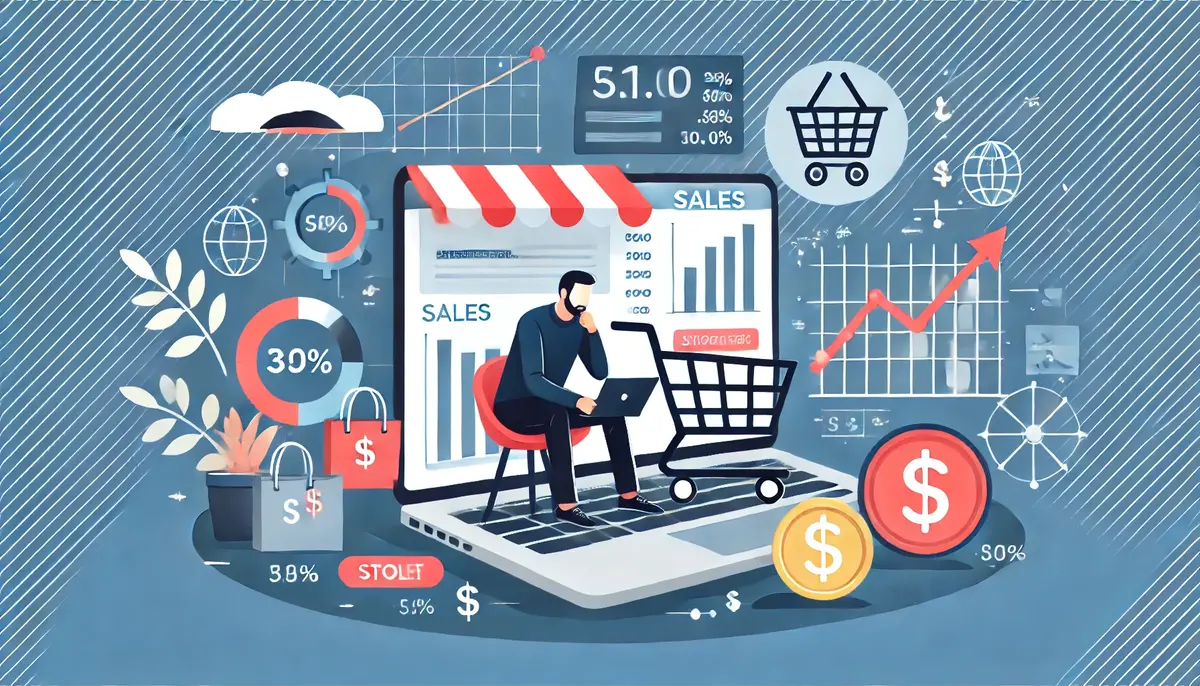In ecommerce, having a robust sales strategy is a necessity. The online marketplace is saturated with competitors, each vying for the attention of potential customers. To stand out, you need a well-crafted strategy that not only attracts visitors but also converts them into loyal, repeat buyers.
This comprehensive guide for beginners looks into the most effective ecommerce sales strategies that can help you enhance your online presence and significantly boost your revenue.
 Guide to Ecommerce Sales Strategy
Guide to Ecommerce Sales Strategy
Here is our short guide to e-commerce sales strategies:
Understanding Your Target Audience
Understanding your target audience is the foundation of any successful ecommerce strategy. Without a clear understanding of who your customers are, your marketing efforts can be unfocused and ineffective.
- Demographic Analysis: Start by identifying the basic demographics of your audience, such as age, gender, income level, education, and geographic location. This information helps you create targeted marketing campaigns that resonate with specific segments of your audience.
- Behavioral Analysis: Understanding the behavior of your audience is crucial. Analyze their purchasing habits, browsing patterns, and how they interact with your website. This can help you identify which products are most popular, peak shopping times, and common paths to purchase.
- Psychographic Analysis: Delve deeper into the psychological aspects of your customers. Understand their interests, values, lifestyle, and motivations. Psychographic insights can help you create highly personalized marketing messages that connect with your audience on a deeper level.
- Personalization: Use the data gathered from demographic, behavioral, and psychographic analyses to personalize your marketing efforts. Tailor your email campaigns, website content, and advertisements to meet the specific needs and preferences of different customer segments. Personalization can significantly enhance the customer experience and increase conversion rates.
Optimizing Your Website for Conversions
Your website is the storefront of your ecommerce business. To maximize sales, it’s essential to optimize your site for conversions.
- Mobile Responsiveness: With more than half of online shopping done via mobile devices, having a mobile-responsive website is critical. Ensure that your site is easy to navigate and functions smoothly on all devices, including smartphones and tablets.
- Easy Navigation and Search Functionality: Simplify the user experience by providing easy navigation and a robust search functionality. Make it easy for customers to find the products they’re looking for with well-organized categories, filters, and search bars.
- High-Quality Product Images and Descriptions: High-quality images and detailed product descriptions can make a significant difference in persuading visitors to make a purchase. Use multiple images to showcase products from different angles and provide thorough descriptions that highlight key features and benefits.
- Customer Reviews and Testimonials: Including customer reviews and testimonials adds credibility and helps build trust. Potential buyers are more likely to purchase a product if they see positive feedback from other customers.
- A/B Testing: Regular A/B testing allows you to identify what works best on your website. Test different elements such as headlines, images, call-to-action buttons, and layouts to determine which versions perform better. Continuous improvement through A/B testing can lead to higher conversion rates.
Leveraging Data and Analytics
Data-driven decision-making is a game-changer in ecommerce. Utilizing analytics tools can provide valuable insights into your website’s performance and customer behavior.
- Analytics Tools: Use tools like Google Analytics, Shopify Analytics, and SEMrush to gather data on your site’s performance. These tools can help you track key metrics such as traffic sources, bounce rates, and conversion rates.
- Key Metrics to Track: Focus on metrics that provide insights into your sales performance. Important metrics to track include conversion rate (the percentage of visitors who make a purchase), cart abandonment rate (the percentage of visitors who add items to their cart but do not complete the purchase), and customer lifetime value (the total revenue generated by a customer over their lifetime).
- Using Data to Personalize Marketing: Analyzing customer data allows you to create personalized marketing campaigns. For example, you can segment your email list based on past purchase behavior and send targeted promotions to specific groups. Personalization can lead to higher engagement and conversion rates.
Enhancing Customer Experience
Providing an excellent customer experience is crucial for retaining customers and driving sales. Happy customers are more likely to become repeat buyers and advocates for your brand.
- Live Chat Support: Implementing live chat support can address customer queries in real-time, improving satisfaction and reducing cart abandonment. Ensure that your live chat is easily accessible and staffed with knowledgeable representatives.
- Easy Return and Refund Policies: Having a straightforward return and refund policy can make customers more comfortable making purchases. Clearly outline your policies on your website and ensure that the process is easy for customers to follow.
- Loyalty Programs and Rewards: Loyalty programs and rewards incentivize repeat purchases. Offer points for purchases, referrals, and social media engagement that customers can redeem for discounts or free products.
- Using AI and Chatbots: Incorporating AI and chatbots can streamline customer service, providing quick and efficient responses to common inquiries. Chatbots can handle simple tasks like tracking orders and answering frequently asked questions, freeing up your team to focus on more complex issues.
Effective Marketing Strategies
Marketing is the lifeblood of any ecommerce business. Implementing a mix of marketing channels ensures you reach a broader audience and engage them effectively.
- Email Marketing: Email marketing remains one of the most effective ways to engage with customers. Build a strong email list and send regular newsletters with updates, promotions, and personalized recommendations. Segment your list to ensure that each group receives relevant content.
- Social Media Marketing: Social media platforms are powerful tools for reaching potential buyers. Create engaging content that resonates with your audience and encourages sharing. Use social media ads to target specific demographics and drive traffic to your website.
- Content Marketing: Content marketing, through blogs, videos, and infographics, establishes your brand as an authority in your niche. Create high-quality content that provides value to your audience and addresses their pain points. This can drive organic traffic and improve your search engine rankings.
- Influencer Marketing: Collaborating with influencers in your niche can expand your reach and build trust with potential customers. Choose influencers who align with your brand values and have a strong following among your target audience.
- Omnichannel Marketing: An omnichannel approach ensures a seamless experience across all touchpoints. Integrate your marketing efforts across email, social media, content, and paid advertising to create a cohesive and consistent brand message, while leveraging omnichannel personalization to tailor experiences to individual customer preferences.
Utilizing SEO to Drive Traffic
Search Engine Optimization (SEO) is vital for driving organic traffic to your ecommerce site. A well-optimized site can improve your search rankings and attract more visitors.
- On-Page SEO: On-page SEO involves optimizing individual pages on your site to rank higher in search engine results. Use relevant keywords in your product titles, descriptions, and meta tags. Ensure that your content is high-quality and provides value to your audience. Internal linking helps with site navigation and distributes page authority.
- Off-Page SEO: Off-page SEO focuses on building your site’s authority through external means. Strategies include backlink building, guest blogging, and influencer outreach. High-quality backlinks from reputable sites can improve your search rankings and drive more traffic to your site.
- Content Creation: Creating high-quality content that addresses the needs and interests of your audience is crucial for SEO. Regularly update your blog with informative articles, guides, and tutorials. Use relevant keywords naturally within your content to improve your search visibility.
Leveraging Paid Advertising
Paid advertising can provide a significant boost to your ecommerce sales. Platforms like Google Ads, Facebook Ads, and Instagram Ads allow you to target specific audiences with tailored messages.
- Setting Clear Goals and KPIs: Define what you want to achieve with your ad campaigns and set clear key performance indicators (KPIs) to measure success. Common goals include increasing website traffic, generating leads, and driving sales.
- Targeting the Right Audience: Use detailed targeting options to reach your ideal customers. Consider factors like demographics, interests, and behaviors to ensure your ads are seen by those most likely to convert.
- Crafting Compelling Ad Copy and Visuals: Create ad copy and visuals that resonate with your target audience. Highlight the benefits of your products and include a strong call to action. A/B tests different versions of your ads to see which performs best.
Preparing for Peak Seasons
Planning for peak shopping seasons is essential for maximizing sales. Whether it’s Black Friday, Cyber Monday, or the holiday season, being prepared can make a significant difference.
- Early Promotions and Teasers: Start your promotions early to build anticipation. Use email and social media to create buzz around upcoming sales and special offers.
- Stocking Up on Inventory: Ensure that you have adequate inventory to meet increased demand. Running out of stock during peak season can lead to lost sales and disappointed customers.
- Enhancing Website Performance: Peak seasons often bring a surge in website traffic. Ensure that your site can handle higher volumes without slowing down or crashing. Optimize your site’s performance and consider using a content delivery network (CDN) to improve load times.
Retargeting and Upselling
Retargeting past visitors and customers can significantly boost sales. Dynamic retargeting ads show users products they viewed previously, encouraging them to return and complete their purchase.
- Retargeting Strategies: Use retargeting ads to remind customers of abandoned carts or suggest related products. Personalized email campaigns can also be effective in bringing customers back to your site.
- Upselling and Cross-Selling: Implement upselling and cross-selling techniques to increase the average order value. Recommend higher-end products or complementary items based on what customers are viewing or purchasing. Offer bundling deals or loyalty discounts to incentivize additional purchases.
Conclusion
Implementing these comprehensive ecommerce sales strategies can help you enhance your online store’s performance and boost revenue. By understanding your audience, optimizing your website, leveraging data, and using effective marketing techniques, you can stand out in the competitive ecommerce landscape. Remember, continuous learning and adaptation are key to staying ahead of the competition.







